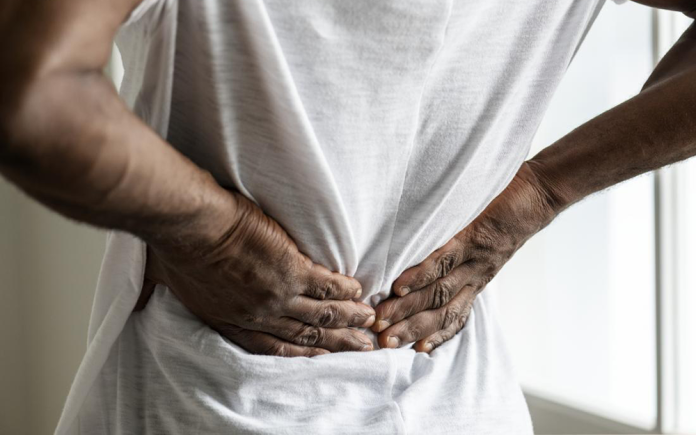
By Coach Nadia Popova
Your lower back provides support and stability to your body when you’re in an upright position. Each vertebra is separated by a jelly-filled disc that serves as a cushion. These discs can become inflamed when standing for long periods of time. They can also experience wear and tear with age. Standing or walking for extended periods of time may aggravate this inflammation, resulting in pain
Possible Causes of lower back pain.
Stress. Standing or walking for long periods of time places stress on your lower back. In addition to the actual pressure on lumbar vertebrae, if you’re standing at a high-demand job, your back muscles may tense as well, increasing the pain.
Being overweight. Every pound of excess weight places an additional four pounds of stress on your joints. This includes what’s called the facet joints, which are located between vertebrae. These are the joints that allow your back to be flexible when you have to bend down or twist around.
Poor posture. Having poor posture for a day or two won’t really cause damage to your back. But do it over the span of several years, and it will affect the anatomy of your spine: Discs, joints, muscles, ligaments, blood vessels, and nerves on your back will all experience additional stress.
Sedentary lifestyle. Inactivity leads to what’s called sedentary lifestyle. If you are used to having a sedentary lifestyle, you could inadvertently be causing the deterioration of your musculoskeletal system. As a result, you’ll experience a long list of health ailments, including chronic lower back pain.
You need to replace your mattress. Not all mattresses are created equal. If you bought yours because it was on sale on Memorial Day, without regard for what your body actually needs, or if you purchased it over ten years ago, it may be time to revisit that decision and look for one that takes into account your body type, weight, preferred sleeping position, or any back condition that may require additional spinal support.
Keeping your back healthy at every age
It’s crucial to move your body and strengthen back and abdominal muscles to help keep discomfort at bay. Regular exercise not only reduces your risk of age-related back pain, but it can also prevent additional deterioration if damage already exists.
In addition to engaging in regular exercise and strength training, you can also keep your spine healthy by:
- Maintaining a healthy weight
- Consuming a nutritious diet
- Quitting smoking
- Avoiding activities that can cause back strain or injury
- Practicing good posture, body mechanics, and ergonomics
- Following good sleeping habits
- Learning to manage stress
3 exercises to help with pain
- Supine bridge
Lie on your back with your arms on the floor at your sides, your legs bent at the knees and your feet flat on the floor. Tighten your abdomen and glutes and slowly lift your hips off the floor, while keeping your back straight. Then, slowly lower your butt and hips back down to the floor. Do 10 repetitions.
- Bird Dog
Get down on all fours, with your hands on the floor directly under both shoulders and your knees directly under your hips. Keep your head in line with your spine and lift your right arm forward and your left leg straight behind you until they are both parallel to the floor. Pause, then return to the starting position. Repeat with the left arm and the right leg. Be sure to keep your abdominal muscles tight, your back flat and your hips level throughout the exercise. Do 10 repetitions on each side.
- Child’s Pose
While you’re still on your hands and knees, push your butt back onto your heels, with your knees apart. Lower your upper body between your knees, stretch your arms along the floor above your head and place your forehead on or near the floor. Hold this position for 20 to 30 seconds.
Preventing Back Pain.
Some types of reoccurring back pain can be prevented. Here are 8 ways to help keep your back healthy:
- Exercise regularly to keep muscles strong and flexible.
- Maintain a healthy weight.
- Eat a healthy diet and make sure you get enough calcium, phosphorus and vitamin D.
- Use ergonomically designed furniture and equipment at home and at work.
- If you sit a lot at work, switch sitting positions often. Also, get up every now and then and walk around the office or stretch to relieve muscle tension.
- Wear comfortable, low-heeled shoes.
- Sleep on a firm surface. Sleeping on your side in a fetal position can help relieve pressure on the spine.
- Don’t try to lift objects that are too heavy
If you need help with the regular exercises that will help strengthen your abdominal muscles to prevent and reduce lower back pain our Team of Qualified Personal Trainers can help. Also we have a Stretching Therapist who can help significantly reduce existing lower back pain. Please reach out to us (760)880-9904 or visit our Website: www.cvsendmeatrainer.com











































